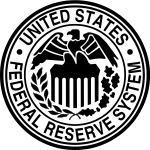Aldrich–Vreeland Act
The Aldrich–Vreeland Act was passed in response to the Panic of 1907 and established the National Monetary Commission, which recommended the Federal Reserve Act of 1913.
On May 27, 1908, the bill passed the House on a mostly party-line vote of 166–140, with 13 Republicans voting against it and no Democrats voting for it.[1] On May 30, it passed in the Senate with 43 Republicans in favor and five Republicans joining 17 Democrats opposed. President Roosevelt signed the bill that same night.[2]
The act also allowed national banks to start national currency associations in groups of ten or more, with at least $5 million in total capital, to issue emergency currency. These bank notes were to be backed by not just government bonds but also just about any securities the banks were holding. The act proposed that this emergency currency had to go through a process of approval by the officers of these national currency associations and then distributed by the Comptroller of the Currency.
However, it is possible that because there was a 5 percent tax placed on this emergency currency for the first month it was "outstanding" and a 1 percent increase for the following months it was "outstanding," no bank notes were issued. Another possible explanation that the emergency currency was never issued might have been that it was unnecessary.[3]
Congress modified and extended the law in 1914 when British and other foreign creditors demanded immediate payments, in gold, of amounts which would ordinarily have been carried over and paid through exports of commodities.
Senator Nelson W. Aldrich (R-RI) was largely responsible for the Aldrich-Vreeland Currency Law and became the Chairman of the National Monetary commission. The co-sponsor of the legislation was Rep. Edward Vreeland, a Republican from New York.
A usage of the law occurred at the outbreak of the World War I in 1914 when the first great financial panic of the 20th century befell the world, necessitating the closure of the New York Stock Exchange. Secretary of the Treasury William Gibbs McAdoo appeared in New York City and assured the public that ample stocks of emergency banknotes had been prepared in accordance with the Aldrich–Vreeland Act and were available for issue to the banks. As of October 23, 1914, $368,616,990 was outstanding.
The Federal Reserve Act of December 23, 1913 took effect in November 1914 when the 12 regional banks opened for business. Ultimately the emergency currency issued under the Aldrich-Vreeland Law was entirely withdrawn.
References
- ↑ "New currency bill passes the House". The New York Times. May 28, 1908. p. 1.
- ↑ "Pass currency bill by Aldrich strategy". The New York Times. May 31, 1908. p. 1.
- ↑ Wells, Donald. The Federal Reserve System: A History. Jefferson: McFarland and Company, 2004.
Further reading
- Silber, William L. "The Great Financial Crisis of 1914: What Can We Learn from Aldrich-Vreeland Emergency Currency?." American economic review (2007): 285-289. online
- Laughlin, J. Laurence. "The Aldrich-Vreeland Act." Journal of Political Economy (1908) 16#8 pp: 489-513. in JSTOR
- West, Robert Craig. Banking reform and the Federal Reserve, 1863-1923 (Cornell University Press, 1977)
- Wicker, Elmus. The Great Debate on Banking Reform: Nelson Aldrich and the Origins of the Fed (Ohio State University Press, 2005)
